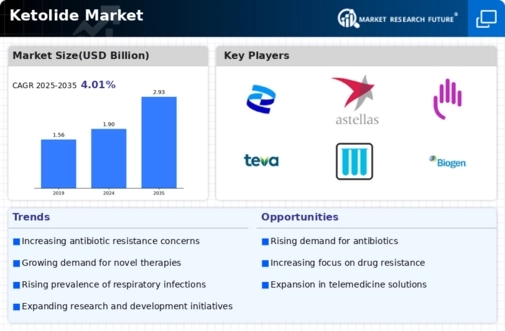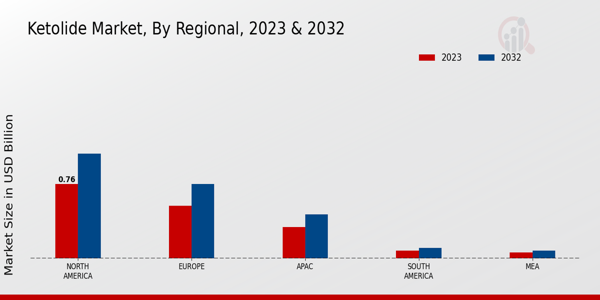Market Growth Projections
The Global Ketolide Market Industry is poised for substantial growth, with projections indicating a market value of 1.9 USD Billion in 2024 and an anticipated increase to 2.93 USD Billion by 2035. This growth trajectory is supported by a compound annual growth rate of 4.03% from 2025 to 2035. Factors contributing to this expansion include rising antibiotic resistance, increasing applications in respiratory infections, and supportive regulatory frameworks. As the market evolves, it is expected that new ketolide products will emerge, further driving growth and innovation within the industry.
Rising Antibiotic Resistance
The increasing prevalence of antibiotic resistance is a critical driver for the Global Ketolide Market Industry. As traditional antibiotics become less effective against resistant bacterial strains, there is a growing demand for novel antibiotics, including ketolides. These compounds, which are derived from macrolides, have shown efficacy against resistant pathogens such as Streptococcus pneumoniae. The urgency to address antibiotic resistance is underscored by the World Health Organization's reports, which indicate that antibiotic-resistant infections could lead to 10 million deaths annually by 2050. This scenario propels the Global Ketolide Market Industry towards innovation and development of new therapeutic options.
Investment in Research and Development
The Global Ketolide Market Industry is significantly influenced by ongoing investments in research and development. Pharmaceutical companies are increasingly focusing on developing new ketolide derivatives that can combat resistant bacterial strains. This investment is driven by the need for innovative solutions in the face of rising antibiotic resistance. For example, research initiatives funded by government health agencies aim to explore the efficacy of ketolides in various therapeutic areas. Such efforts not only enhance the understanding of ketolides but also pave the way for new product launches, thereby expanding the market. The anticipated growth trajectory indicates a market value of 2.93 USD Billion by 2035.
Growing Awareness of Infectious Diseases
There is a growing awareness of infectious diseases and their impact on public health, which serves as a significant driver for the Global Ketolide Market Industry. Educational campaigns and health initiatives are raising awareness about the dangers of antibiotic resistance and the importance of effective treatment options. This heightened awareness is leading to increased demand for ketolides, particularly in regions where infectious diseases are prevalent. As healthcare providers become more informed about the benefits of ketolides, their adoption in clinical practice is likely to rise. This trend contributes to the overall growth of the market, aligning with the projected increase in market value over the coming years.
Regulatory Support for Antibiotic Development
Regulatory bodies worldwide are providing support for the development of new antibiotics, including ketolides, which is a crucial driver for the Global Ketolide Market Industry. Initiatives such as the Generating Antibiotic Incentives Now Act in the United States aim to expedite the approval process for novel antibiotics. This regulatory environment encourages pharmaceutical companies to invest in the development of ketolides, which are essential in addressing the urgent need for effective treatments against resistant bacteria. As a result, the market is likely to experience growth, with a projected compound annual growth rate of 4.03% from 2025 to 2035, reflecting the increasing focus on antibiotic innovation.
Expanding Applications in Respiratory Infections
Ketolides are increasingly recognized for their potential in treating respiratory infections, particularly community-acquired pneumonia. The Global Ketolide Market Industry benefits from the rising incidence of such infections, which are often caused by resistant bacteria. For instance, telithromycin, a prominent ketolide, has been approved for treating these infections, showcasing its effectiveness against pathogens that are resistant to other antibiotics. As the global population ages and respiratory diseases become more prevalent, the demand for effective treatments is likely to rise. This trend is projected to contribute to the market's growth, with estimates suggesting a market value of 1.9 USD Billion in 2024.













